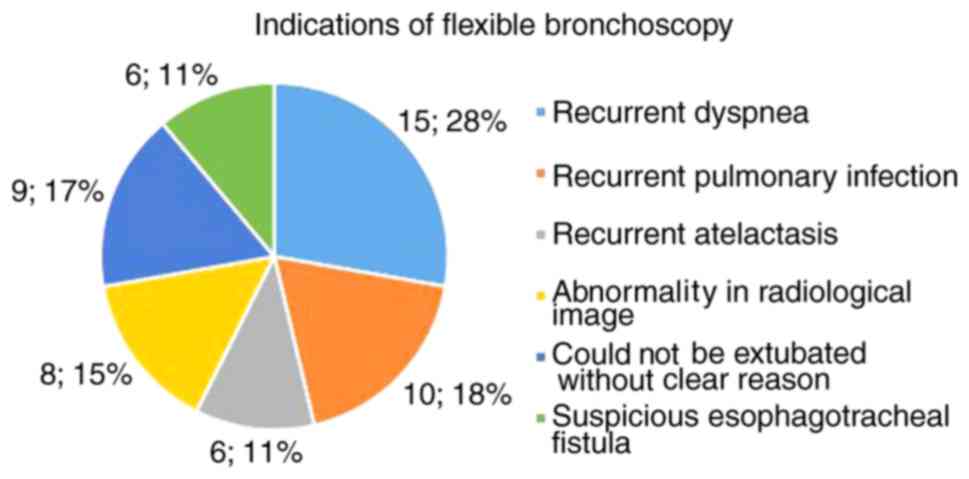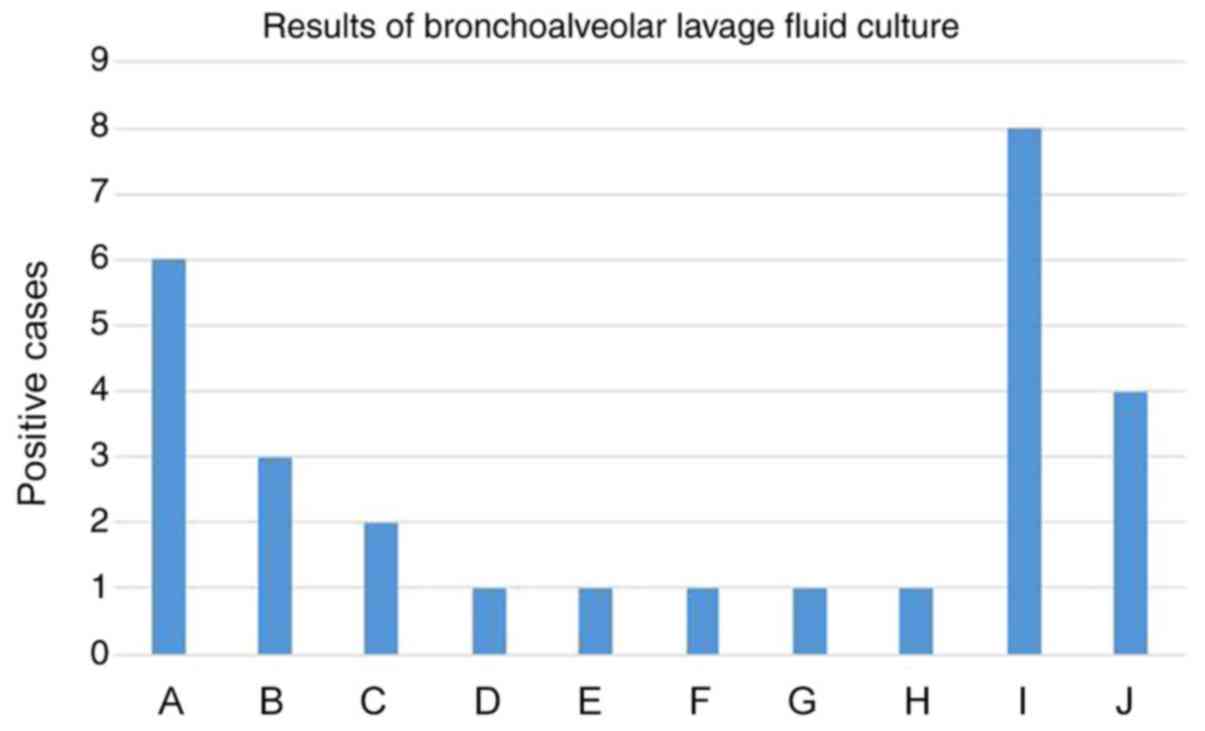|
1
|
Pereira W, Kovnat DM, Khan MA, Iacovino
JR, Spivack ML and Snider GL: Fever and pneumonia after flexible
fiberoptic bronchoscopy. Am Rev Respir Dis. 112:59–64.
1975.PubMed/NCBI View Article : Google Scholar
|
|
2
|
Zhang W, Yang YX, Yu W and Qi SH: Cough
Suppression during flexible bronchoscopy using transcutaneous
electric acupoint stimulation: A randomized controlled study. Evid
Based Complement Alternat Med. 2019(5650413)2019.PubMed/NCBI View Article : Google Scholar
|
|
3
|
Ndilanha DA, Shayo GA, Hassan R,
Byomuganyizi M and Lema LEK: Diagnoses from lung specimen collected
through flexible bronchoscopy from patients in a tertiary hospital
in Dar es Salaam Tanzania: A retrospective cross-sectional study.
BMC Pulm Med. 19(214)2019.PubMed/NCBI View Article : Google Scholar
|
|
4
|
Sachdev A, Chhawchharia R, Gupta D and
Gupta N: Flexible fiberoptic bronchoscopy directed interventions in
neonatal intensive care unit. Indian Pediatr. 56:563–565.
2019.PubMed/NCBI
|
|
5
|
The Pediatric Bronchoscopy Collaborative
Group, the Subspecialty Group of Respiratory Diseases, the Society
of Pediatrics, Chinese Medical Association. Guide to pediatric
bronchoscopy (2009 edition). Chin J Pediatr. 47:740–744.
2009.PubMed/NCBI
|
|
6
|
Pérez-Frías J, Moreno Galdó A, Pérez Ruiz
E, Barrio Gómez De Agüero MI, Escribano Montaner A and Caro
Aguilera P: Sociedad Española de Neumología y Cirugía Torácica.
Pediatric bronchoscopy guidelines. Arch Bronconeumol. 47:350–360.
2011.PubMed/NCBI View Article : Google Scholar : (In Spanish).
|
|
7
|
Hysinger EB, Hart CK, Burg G, De Alarcon A
and Benscoter D: Differences in flexible and rigid bronchoscopy for
assessment of tracheomalacia. Laryngoscope: Apr 13, 2020 (Epub
ahead of print). doi: 10.1002/lary.28656.
|
|
8
|
He SR, Sun YX, Yu YH, Liu YM, Zhong J,
Liang SX, et al: The applications of flexible fiberoptic
bronchoscopy in NICU. J Clin Pediatr. 27:18–21. 2009.
|
|
9
|
Pan W, Peng D, Luo J, Liu E, Luo Z, Dai J,
Fu Z, Li Q and Huang Y: Clinical features of airway malacia in
children: A retrospective analysis of 459 patients. Int J Clin Exp
Med. 7:3005–3012. 2014.PubMed/NCBI
|
|
10
|
Daniel SJ: The upper airway: Congenital
malformations. Paediatr Respir Rev. 7 (Suppl 1):S260–S263.
2006.PubMed/NCBI View Article : Google Scholar
|
|
11
|
Ayari S, Aubertin G, Girschig H, Van Den
Abbeele T, Denoyelle F, Couloignier V and Mondain M: Management of
laryngomalacia. Eur Ann Otorhinolaryngol Head Neck Dis. 130:15–21.
2013.PubMed/NCBI View Article : Google Scholar
|
|
12
|
Thorne MC and Garetz SL: Laryngomalacia:
Review and summary of current clinical practice in 2015. Paediatr.
Respir Rev. 17:3–8. 2016.PubMed/NCBI View Article : Google Scholar
|
|
13
|
Erdem E, Gokdemir Y, Unal E, Ersu R,
Karadag B and Karakoc F: Flexible bronchoscopy as a valuable tool
in the evaluation of infants with stridor. Eur Arch
Otorhinolaryngol. 270:21–25. 2013.PubMed/NCBI View Article : Google Scholar
|
|
14
|
Olney DR, Greinwald JH Jr, Smith RJ and
Bauman NM: Laryngomalacia and its treatment. Laryngoscope.
109:1770–1775. 1999.PubMed/NCBI View Article : Google Scholar
|
|
15
|
Majid A, Fernandez L, Bussy SF, Herth F
and Ernst A: Tracheobronchomalacia. Arch Bronconeumol. 46:196–202.
2010.PubMed/NCBI View Article : Google Scholar : (In Spanish).
|
|
16
|
Hysinger EB and Panitch HB: Paediatric
Tracheomalacia. Paediatr Respir Rev. 17:9–15. 2016.PubMed/NCBI View Article : Google Scholar
|
|
17
|
Wright CD: Treatment of congenital
tracheal stenosis. Thorac Cardiovasc Surg. 21:274–277.
2009.PubMed/NCBI View Article : Google Scholar
|
|
18
|
Jaquiss RD: Management of pediatric
tracheal stenosis and tracheomalacia. Semin Thorac Cardiovasc Surg.
16:220–224. 2004.PubMed/NCBI View Article : Google Scholar
|
|
19
|
Fraga JC, Jennings RW and Kim PC:
Pediatric tracheomalacia. Semin Pediatr Surg. 25:156–164.
2016.PubMed/NCBI View Article : Google Scholar
|
|
20
|
Lee S, Cheung YF, Leung MP, Ng YK and Tsoi
NS: Airway obstruction in children with congenital heart disease:
Assessment by flexible bronchoscopy. Pediatr Pulmonol. 34:304–311.
2002.PubMed/NCBI View Article : Google Scholar
|
|
21
|
Yang ZY, Liang L, Liu WJ, Zhang Q, Jin DQ,
Jiang R, et al: Application of fiberoptic bronchoscopy on diagnosis
and treatment of respiratory comorbidity in children with
congenital heart disease. J Appl Clin Pediatr. 26:260–261.
2011.
|
|
22
|
Sun YX, He SR, Liang SX, Zhong J, Liu YM,
Ge PJ, et al: Dilation guided by fiberoptic bronchoscope treating
for subglottic stenosis in infants. J Appl Clin Pediatr.
25:1758–1761. 2010.
|
|
23
|
Atzori P, Lacobelli BD, Bottero S,
Spirydakis J, Laviani R, Trucchi A, Braguglia A and Bagolan P:
Preoperative tracheobronchoscopy in newborns with esophageal
atresia: Does it matter? J Pediatr Surg. 41:1054–1057.
2006.PubMed/NCBI View Article : Google Scholar
|
|
24
|
Parolini F, Boroni G, Stefini S, Agapiti
C, Bazzana T and Alberti D: Role of preoperative
tracheobronchoscopy in newborns with esophageal atresia: A review.
World J Gastrointest Endosc. 6:482–487. 2014.PubMed/NCBI View Article : Google Scholar
|
|
25
|
Antabak A, Luetic T, Caleta D and Romic I:
H-type tracheoesophageal fistula in a newborn: Determining the
exact position of fistula by intra-operative guidewire placement. J
Neonatal Surg. 3(36)2014.PubMed/NCBI
|
|
26
|
Finke MD: Transtracheal wash and
bronchoalveolar lavage. Top Companion Anim Med. 28:97–102.
2013.PubMed/NCBI View Article : Google Scholar
|
|
27
|
Torre O and Harari S: The diagnosis of
cystic lung diseases: A role for bronchoalveolar lavage and
transbronchial biopsy? Respir Med. 104 (Suppl 1):S81–S85.
2010.PubMed/NCBI View Article : Google Scholar
|
|
28
|
Palomares LJ, Juan JM, Izquierdo LG,
Dominguez AC, Becerra ER and Panadero FR: Bronchoalveolar lavage
findings in patients with diffuse interstitial lung disease:
Prospective study of a cohort of 562 patients. Arch Bronconeumol.
45:115–121. 2009.PubMed/NCBI View Article : Google Scholar
|
|
29
|
Noël-Georis I, Bernard A, Falmagne P and
Wattiez R: Database of bronchoalveolar lavage fluid proteins. J
Chromatogr B Analyt Technol Biomed Life Sci. 771:221–236.
2002.PubMed/NCBI View Article : Google Scholar
|
|
30
|
Wattiez R and Falmagne P: Proteomics of
bronchoalveolar lavage fluid. J Chromatogr B Analyt Technol Biomed
Life Sci. 815:169–178. 2005.PubMed/NCBI View Article : Google Scholar
|
|
31
|
Tang LF, Xu YC, Wang YS, Wang CF, Zhu GH,
Bao XE, Lu MP, Chen LX and Chen ZM: Airway foreign body removal by
flexible bronchoscopy: Experience with 1027 children during
2000-2008. World J Pediatr. 5:191–195. 2009.PubMed/NCBI View Article : Google Scholar
|
|
32
|
Chen WM, Lu GP, Lu ZJ and Zhang LE: The
application of bronchofibroscope in PICU. Chin Pediatr Emergency
Med. 18:129–132. 2011.
|
|
33
|
Kamat PP, Popler J, Davis J, Leong T,
Piland SC, Simon D, Harsch A, Teague WG and Fortenberry JD: Use of
flexible bronchoscopy in pediatric patients receiving
extracorporeal membrane oxygenation (ECMO) Support. Pediatr
Pulmonol. 46:1108–1113. 2011.PubMed/NCBI View Article : Google Scholar
|
|
34
|
Soong WJ, Lee YS, Tsao PC, Yang CF and
Jeng MJ: Comparison of oxygenation among different supplemental
oxygen methods during flexible bronchoscopy in infants. J Chin Med
Assoc. 74:556–560. 2011.PubMed/NCBI View Article : Google Scholar
|
















